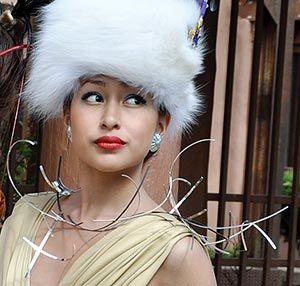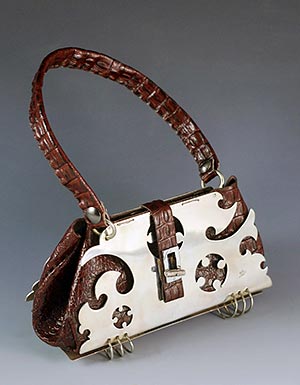Natives look for evolution at Indian Market
By Chee Brossy
Special to the Times
SANTA FE, N.M., Aug. 25, 2011


(Courtesy photos)
TOP: This model shows a necklace by David Gaussoin and a dress by Orlando Dugi. Their work was included in a show Aug. 18 at the Museum of Contemporary Native Art in Santa Fe.
BOTTOM: This purse is an example of new work by Diné designer Orlando Dugi.
"Make it new," said the American writer Ezra Pound. He could have been talking about a literary movement, or the mindset of every would-be iPhone app entrepreneur or about today's Native American art scene.
Making it new is what Native artists are struggling to do and be recognized for in an art environment whose major commercial influence is the annual Santa Fe Indian Market.
Indian Market is at the heart of Santa Fe's summer even as it signals the coming fall. Revelers and tourists create a sea of straw hats in the downtown sun, wandering the booths with heads bent, sometimes looking up to find a partner after a particularly good find.
They come to see silver hammered into squash blossoms and turquoise in clusters, exquisitely painted pottery, paintings with vibrant colors. These are all emblems of Santa Fe and the Southwest in general. But these images haven't changed for some time. Why? Today's Native artists think they know and aim to reshape things. But change is slow.
After graduating from college in 1999, David Gaussoin travelled the world, touring and backpacking through the countries of Europe and Africa. He found new people and new approaches to art and saw the works of Michelangelo, Picasso, and the French Impressionists.
He brought it home with him to Santa Fe and began to put these new influences into his jewelry. And it looked different.
Now Gaussoin, Picuris/Navajo, who comes from a long line of Native jewelers, makes decidedly modern jewelry. Two recent pieces: a necklace of twisted and looped wire that evokes the shiny ribbon of New Years Eve confetti; and a tufa-cast bracelet with organic offshoots of silver, as if the metal is sprouting plantlike tendrils.
But Gaussoin ran into problems when showing the pieces back home.
"They thought my jewelry was too radical," he said, "that I wasn't following the established rules of Indian jewelry. There were people trying to run me out of business."
Gaussoin and his brother Wayne Nez began to make jewelry in their new style and Gaussoin said both Native artists and non-Native buyers didn't like what they were doing.
Indian Market, as the largest Native American art market in the world, played a role in how their jewelry was received, said Gaussoin, and through its standards and judging system was "dictating what was right and wrong" in Indian art.
"I'm an artist," says Gaussoin. "No one should be telling me what's right or wrong, what's traditional or non-traditional when it comes to art. Whenever someone puts standards on what is traditional or non-traditional, I call that censorship."

